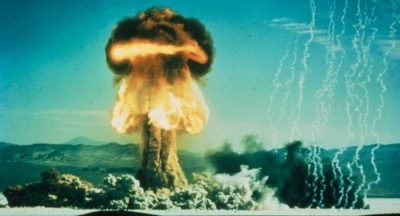NOVANEWS

On 30 August 1945, Major General Lauris Norstad dispatched a document to his superior, General Leslie Groves, outlining a total of 15 “key Soviet cities” to be struck with US atomic weapons, headed by the capital Moscow. This was followed by another 25 “leading Soviet cities” listed for annihilation, topping this latter group was Leningrad, almost destroyed during the Nazi siege finally lifted in late January 1944.
The above nuclear plans were being composed three days before the Second World War had even officially concluded (on 2 September 1945), and a mere two weeks following Japan’s surrender.
These initiatives, targeting the USSR for destruction, were actually developing at least as early as March 1944, at a time when Moscow was a vital wartime ally. Due to ongoing Soviet intelligence reports, Stalin was privy to America’s nuclear project most certainly by April 1942, but quite likely earlier.
Meanwhile, Japan’s political leaders were compelled to surrender on 15 August 1945, after the US military threatened to drop more atomic weapons over the country. This would have just been feasible, with the Pentagon holding a further two atomic bombs in its stockpile during the latter part of 1945.
In the days stretching beyond late August 1945, Groves’ and Norstad’s schemes of ruin were enlarging. On 15 September 1945, a highly classified document relating to their plan expounded in stark tones that,
“The immediate destruction of the enemy’s will [USSR] and capacity to resist is the primary objective of the United States Army Strategic Air Forces”, to be focused upon “the enemy centers of industry, transportation and population”.
That same day, 15 September 1945, Groves and Norstad estimated that over five dozen Soviet metropolises, 66 altogether, should be obliterated with 204 atomic bombs – a “revolutionary” weapon which was “spectacularly successful” in desolating Hiroshima and Nagasaki. It was calculated that these 66 cities held 100% of the Soviet Union’s aluminium production, 97% of its tanks, 95% of its aircraft, 95% of its oil refining capacity, etc.
This declassified material – virtually ignored by commercial media and largely avoided by alternative news – is of particularly high importance, as it blows apart the long-purported myths that the so-called Cold War began in 1947. It further debunks claims that resumption of hostilities was due to Soviet antagonism.
A top secret Pentagon document, once more dated 15 September 1945, outlined explicitly that,
“the destruction of the Russian capability to wage war has therefore been used as a basis upon which to predicate the United States’ atomic bomb requirements”.
Ever eastwards, more than 20 cities in Soviet-occupied Manchuria were also “investigated” for atomic attacks, but it was eventually decided this resource-rich region “is not an integral part of the USSR”.
America’s atomic arsenal unleashed over the Soviet Union would, preferably, be delivered by the upcoming B-36 “Peacemaker” six-engine bomber, with its remarkable 230 foot wingspan – and not, as thought, with the smaller B-29 “Superfortress” aircraft, fresh from discharging two bombs over Japan.
The B-29’s roaming capacity was that of more than 5,000 miles without refuelling, but even this impressive distance had its limitations for what was now envisaged. By comparison, the B-36 boasted a flying range of 10,000 miles.
The B-36 could in fact fly from Washington to Moscow, drop its terrible load, and subsequently return to the American capital without having stopped once there or back (combined distance 9,700 miles). This feat would also have been achievable for the B-36 regarding other Soviet cities such as Leningrad, Kiev, Kharkov, and so on. Yet the B-36 would not be available for such operations until finally entering service during mid-1948, and even after that the aircraft necessitated further adjustment.
Failing the proposed deployment of 204 atomic bombs, a “minimum requirement” of 123 atomic weapons was contemplated, while at the opposite end of the spectrum an “optimum requirement” constituted an eye-watering 466 bombs.
In September 1945 the “minimum requirement” of 123 bombs was not realistic, let alone the 466 figure, and indeed the latter number was then not seriously considered. By June 1948, America’s nuclear cache still consisted of a modest 50 atomic weapons. Moscow was now to be struck with eight bombs, Leningrad with seven.
From mid-1948, America’s atomic numbers ballooned as the age of “nuclear plenty” was born. By the summer of 1949, Washington had the required 200-plus atomic bombs so as to deliver their Soviet apocalypse.
Yet Russia, recognizing the threat facing their state, had feverishly been constructing their own nuclear weapons. Just as the US arsenal was approaching requisite size, in August 1949 the Soviets detonated an atomic device over Semipalatinsk, in north-eastern Kazakhstan.
The USSR’s nuclear explosion, near identical to that of America’s Nagasaki bomb, was detected within days by the US Air Force. After they crosschecked the Soviets’ atomic debris, president Harry Truman, informed of the news, was appalled.
